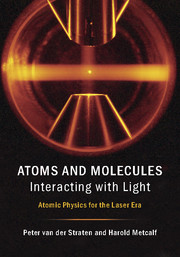Book contents
24 - Fundamental physics
from Part III - Applications
Published online by Cambridge University Press: 05 February 2016
Summary
Atomic physics has played a vital role in defining the progress of physics since the late nineteenth century. One could say that it began with the observation of discrete spectral lines and Balmer's categorization of their wavelengths in the middle 1880s that culminated in the success of the Bohr model 30 years later. Precise spectral measurements led to the discovery of the Zeeman effect, atomic fine structure, the Lamb shift, the anomalous electron magnetic moment, and a host of other phenomena that made great impacts on the physical description of nature.
Apart from precision measurements, atomic and molecular physics experiments have led to a very long list of important discoveries that have had major impacts on fundamental physics. These include, but are not limited to, the discovery of deuterium and thereby the existence of isotopes, violation of the Bell inequalities, the development of the maser and laser, magnetic resonance imaging, and Bose– Einstein condensation along with its impact on condensed matter physics. Modern commercial aviation, the Internet, and the GPS would not exist without the atomic clocks that synchronize them.
Arguably, the origin and development of quantum mechanics was driven by the inconsistencies between laboratory observations and the classical physics of Newton and Maxwell. Most of what was known about nuclear physics in the 1950s was based on atomic hyperfine studies, and there is currently much information on hadron structure derived from atomic physics [322]. Modern field theories derive from quantum electrodynamics that was founded and established by studies of atomic structure.
More recently there there have been attempts to detect an intrinsic electric dipole moment (EDM) of either the electron or the neutron. In the case of the electron, a non-zero EDM would have implications for supersymmetry theories of physics beyond the standard model. Such theories have predictions in the 10-26 to 10-29 e·cm range (1 e·cm = 1.602 178 ×10-21 C · m), and current limits in the few ×10-28 e·cm range are already casting doubt on some of these. By contrast, the standard model without such additions predicts 10-38 e·cm, which is well beyond any current capabilities.
- Type
- Chapter
- Information
- Atoms and Molecules Interacting with LightAtomic Physics for the Laser Era, pp. 448 - 464Publisher: Cambridge University PressPrint publication year: 2016



